Sambar Recipe
Sambar is a traditional South Indian lentil stew made with toor dal (pigeon pea lentils), tamarind, and a medley of vegetables, flavored with a fragrant spice blend (sambar powder) and tempered with mustard seeds, curry leaves, and dried red chilies, typically served with rice, Idli, Dosa or Medu Vada for a comforting and filling meal. I share our favorite South Indian Sambar Recipe which I have perfected over the years. Make this flavorsome, hearty and healthy South Indian vegetable & lentil stew with this easy method.
About Sambar Recipe
Sambar is a South Indian lentil and vegetable stew made with pigeon pea lentils, tamarind and a unique spice blend called sambar powder. It is a staple dish in South Indian homes and is also equally popular and loved by many.
A basic sambar recipe will have a mix or one or two types of vegetables along with lentils, tamarind, sambar powder and a few spices.
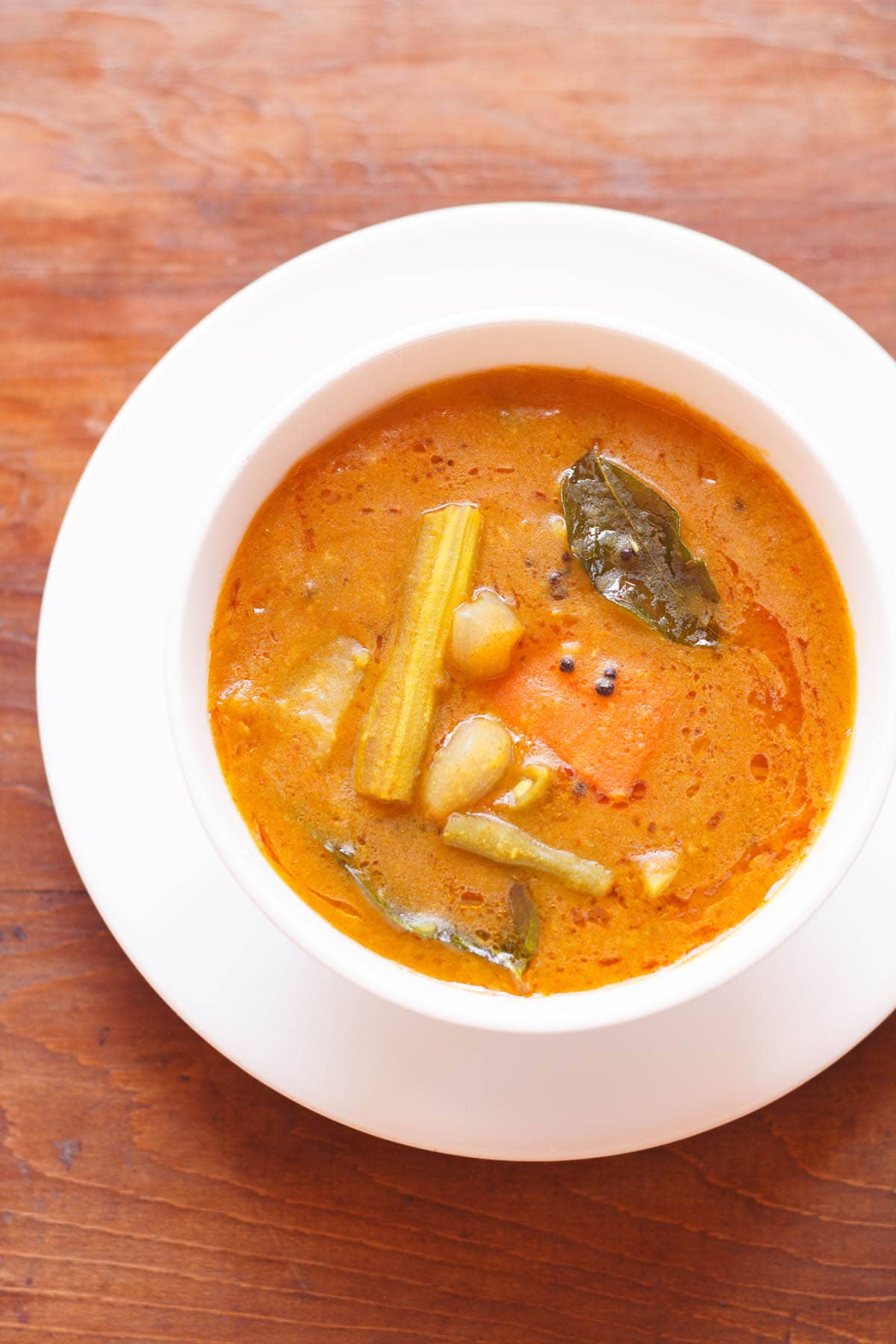
A good sambar powder always yields a good and tasty sambar. so when you make it, try to have a good aromatic sambar powder.
You can also use your favorite brand of sambar powder. I make Sambar Powder at home and I feel homemade sambar powder gives the best and perfect taste in sambar.
If you live outside India and are new to Indian cuisine, then you can find Sambar powder online on amazon or you even find it in an Indian grocery store.
It is healthy as well as nutritious being rich in protein and also other nutrients like vitamins, minerals etc as its made from both lentils and vegetables. Sambar served with rice or idli makes up for a complete meal.
I usually make sambar with this recipe as it is a foolproof method – where both the lentils and vegetables are cooked to perfection. So you do not get half cooked lentils or mushy pasty vegetables. It is also an easy method of making sambar recipe.
I usually add a mix of vegetables from the list mentioned below or just one vegetable in the sambhar. In this sambar recipe, I have added drumstick, okra, pumpkin, carrots, brinjals, french beans and small onions (shallots or pearl onions).
How is it made
A basic South Indian sambar recipe is made by cooking vegetables and lentils separately. The lentils are cooked till it is mushy and then mashed.
Cooked vegetables, mashed dal, tamarind pulp and sambar powder are mixed together and then simmered for some minutes.
Later a tempering is done of oil (or ghee) with mustard seeds, curry leaves, asafoetida (hing) and dry red chilies. This tempering or tadka is added to sambar.
Together with the basic method of making this dish, there are many other regional variations. Sometimes a ground paste of coconut with spices is added.
The kind of spices and their proportions vary with the regional variations. So no two sambar recipes will taste the same as the ingredients and vegetables used differ and vary.
The vegetables can be steamed or boiled in water. According to my experience, when the vegetables are cooked or boiled in water, the broth or stew becomes very flavorful.
The sambar made this way has better flavors as compared to the sambar made with steamed vegetables.
My recipe follows the method of cooking vegetables in water, that makes for a flavorful stew. So when all the elements of the dish come together, what you get is a really delicious complexly flavored sambar recipe.
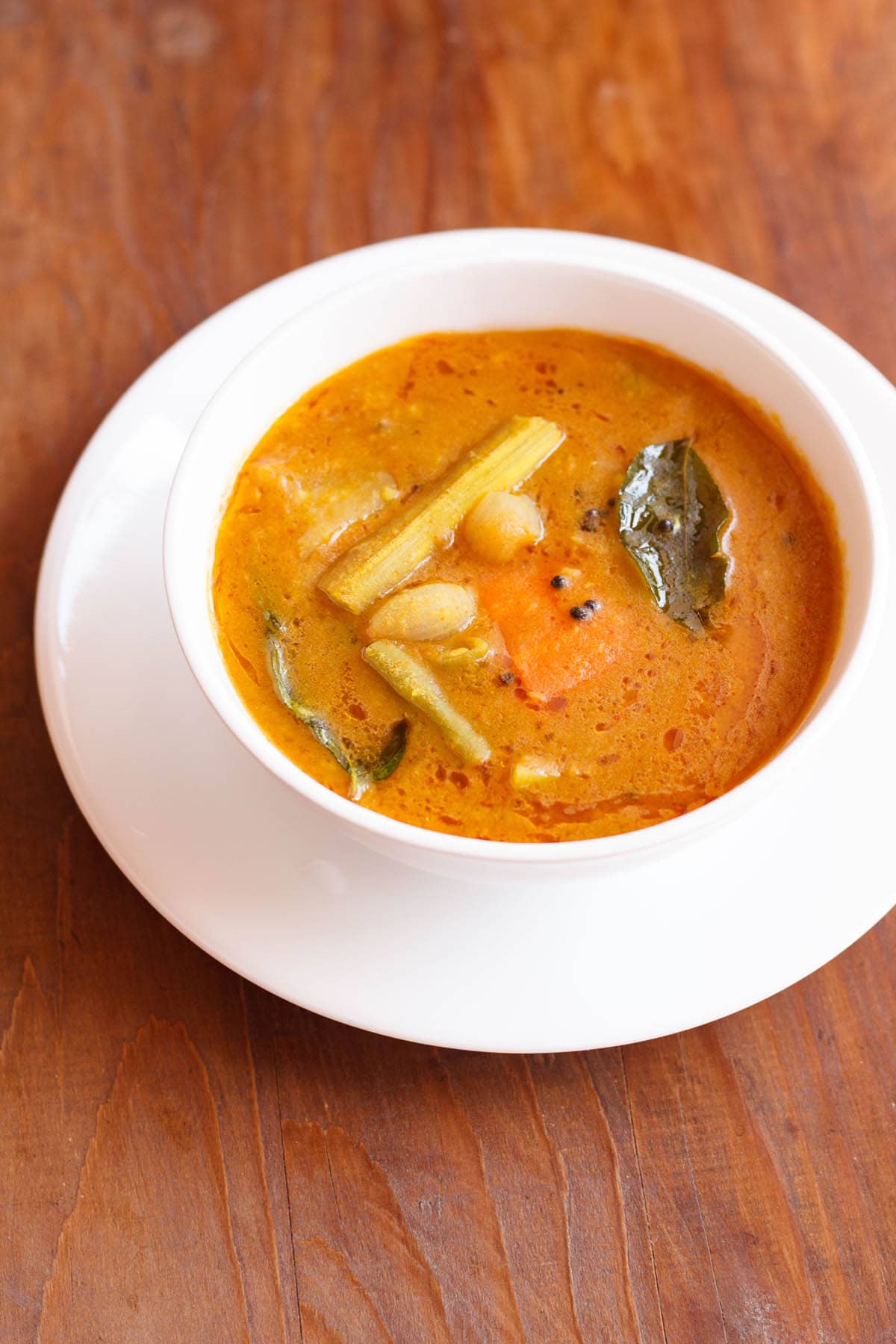
How to make Sambar Recipe
This recipe includes a series of preparations, that are all assembled later together. So you need to make the tamarind pulp, cook vegetables and lentils. Lets begin.
Preparation and Cooking Lentils
1. Before we begin making sambar, it always helps to soak tamarind in water earlier. So soak 1 tablespoon tamarind in ⅓ cup hot water for 20 to 30 minutes.
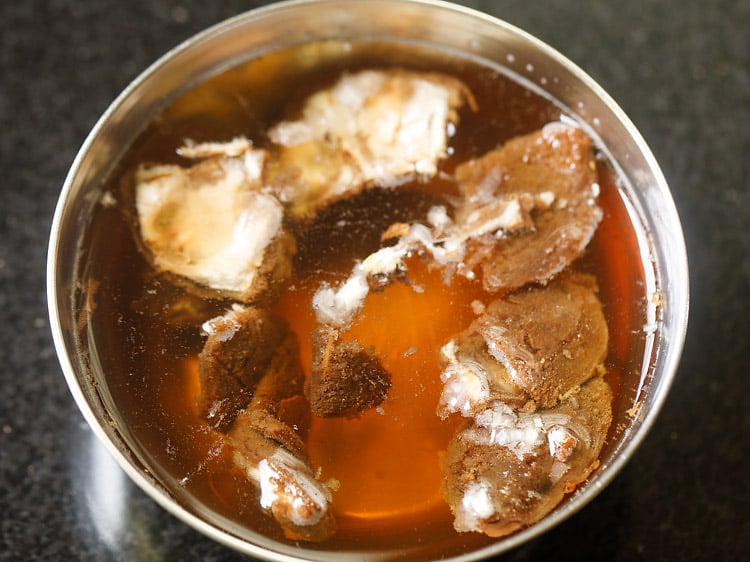
2. Once the tamarind gets soft, then squeeze the tamarind in the water itself. Discard the strained tamarind and keep the tamarind pulp aside.
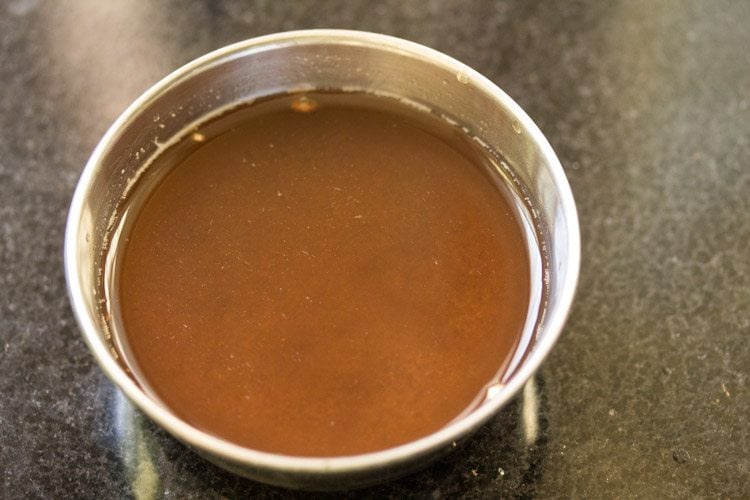
3. Rinse ½ cup tuvar dal (100 grams) a couple of times in fresh and clean water. You can use a strainer to rinse the lentils.
For quick cooking of the lentils you can opt to soak them for an hour prior to cooking.
I recommend to make your sambar recipe with unpolished tuvar dal for a really good taste and more nutrition.
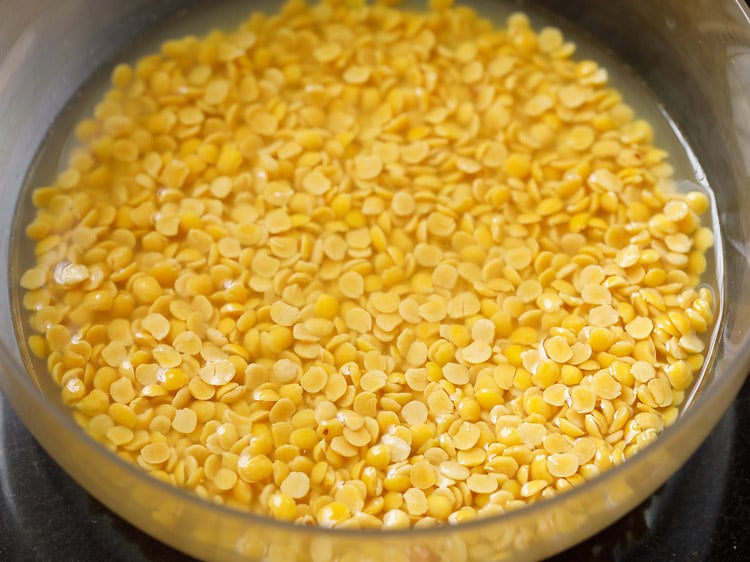
4. Drain all the water and add the dal in a 2 litre stovetop pressure cooker. Also add ¼ teaspoon turmeric powder.
Note: You can also cook the lentils in a pan or instant pot. Add water as needed while cooking the lentils.
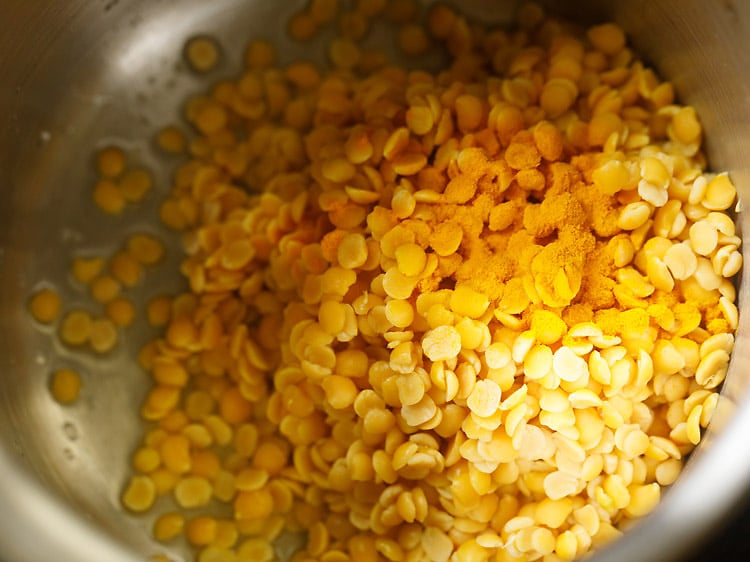
5. Add 1.5 to 1.75 cups of water and mix to combine.
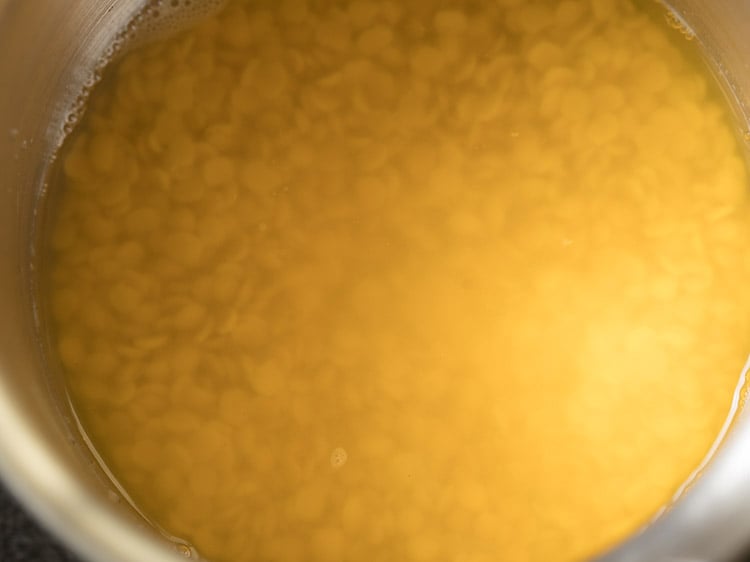
6. Cover and pressure cook dal for 7 to 8 whistles or 9 to 10 minutes on medium heat.
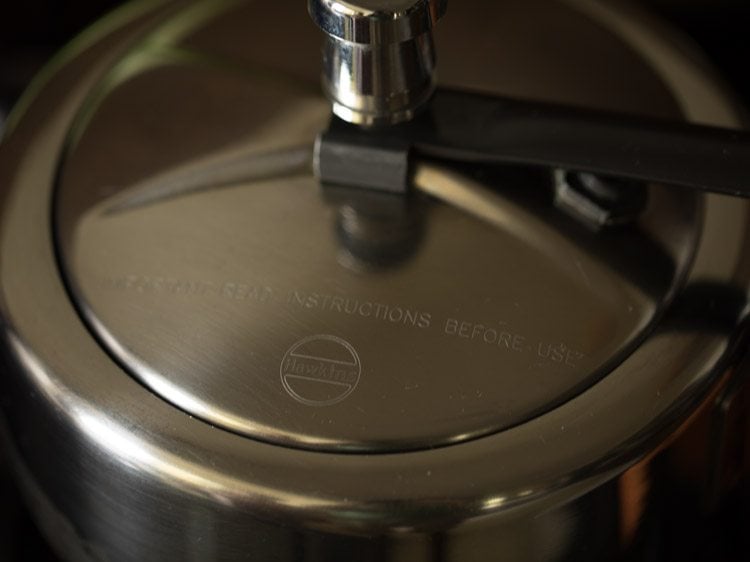
7. When the pressure settles down on its own, open the lid and check the dal. The dal should be completely cooked and mushy.
Mash the dal with a spoon or wired whisk. Cover and keep aside. You can see the consistency of dal in the picture below.
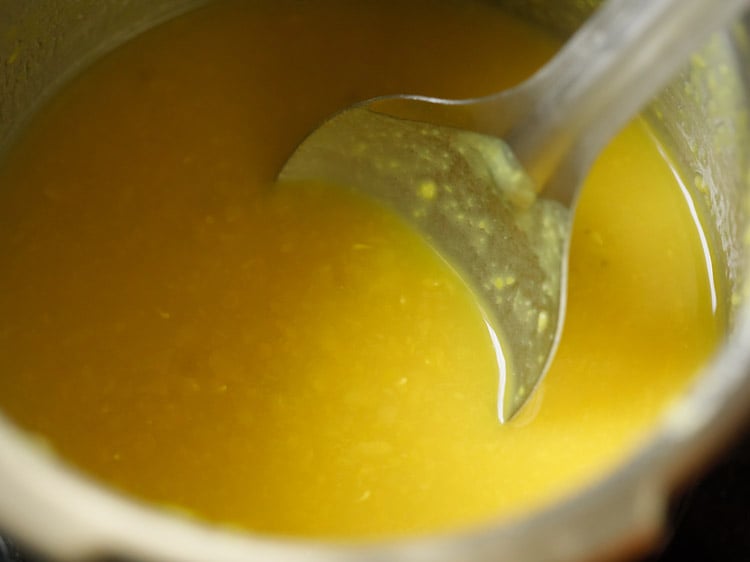
Cook Vegetables
8. When the dal is pressure cooking – rinse, peel and chop the vegetables. When making sambar, chop the vegetables which get cooked faster in large sizes like pumpkin, brinjals (small aubergines) okra, drumsticks etc.
Vegetables which take more time to cook are to be chopped in small sizes like carrots, potatoes, etc. I have chopped the pumpkin in large cubes and the carrots and potatoes in small cubes.
Chop the brinjals before you add them in the pan or else they darken. You will need 1 to 1.5 cup of chopped vegetables.
Note: For best taste and health reasons, I always make sambar with fresh vegetables. However you can use frozen vegetables also.
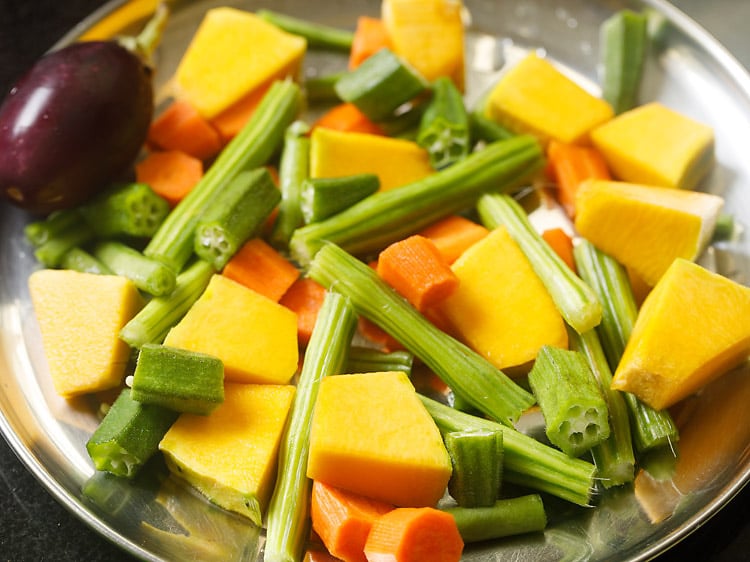
9. Take 1 to 1.5 cups chopped vegetables in a pan or pot. Also add 6 to 7 pearl onions or 1 small to medium onion (thickly sliced) and 1 small to medium tomato (quartered).
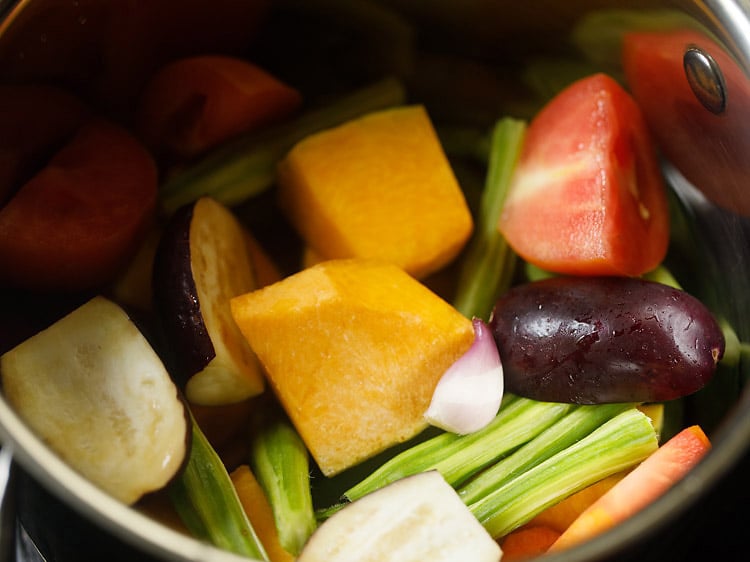
10. Sprinkle ¼ teaspoon turmeric powder, ¼ teaspoon kashmiri red chilli powder and salt as per taste.
Adding kashmiri red chili powder is optional and can be skipped. I add it for a nice bright color in the sambar.
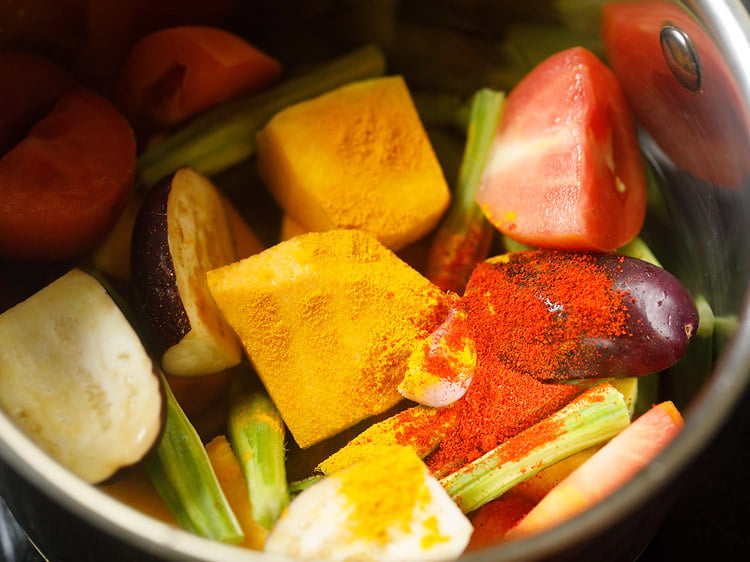
11. Add 1.5 to 2 cups water and stir. Add enough water so that they cover the vegetables.
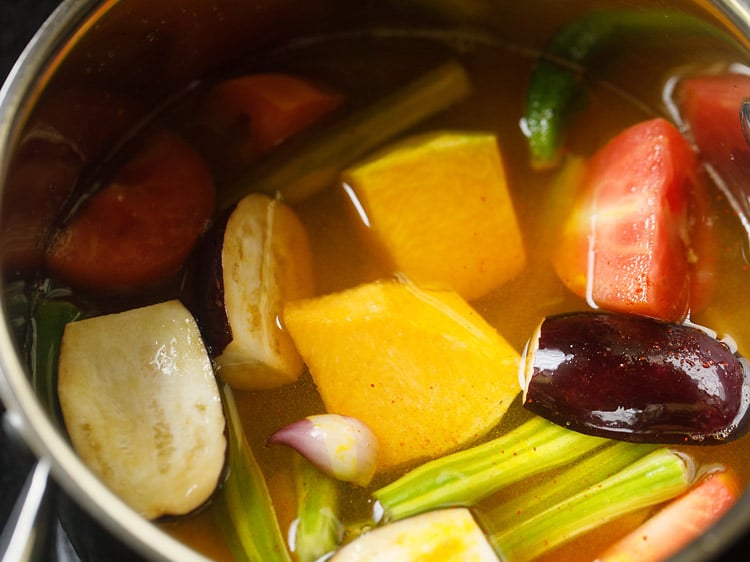
12. Keep the pan on a stove top and begin to cook vegetables on a medium-low to medium heat. In between do check when the vegetables are cooking.
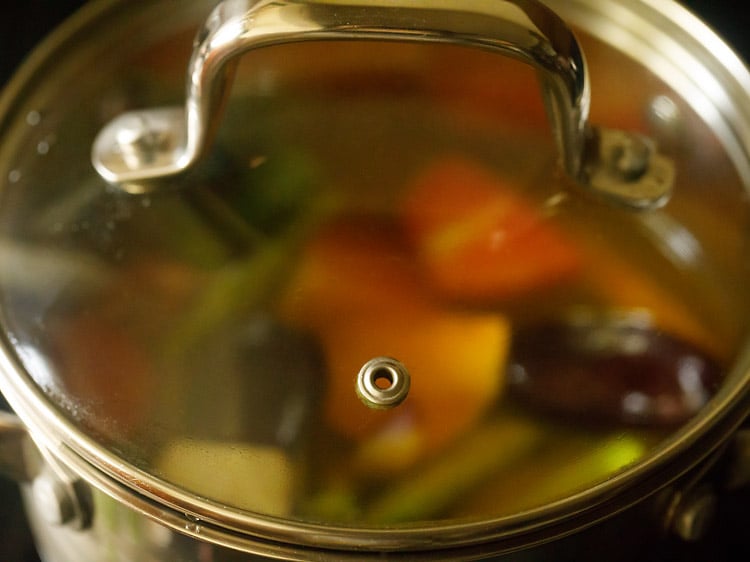
13. Cook till the vegetables are almost done. Ensure that you don’t overcook the vegetables.
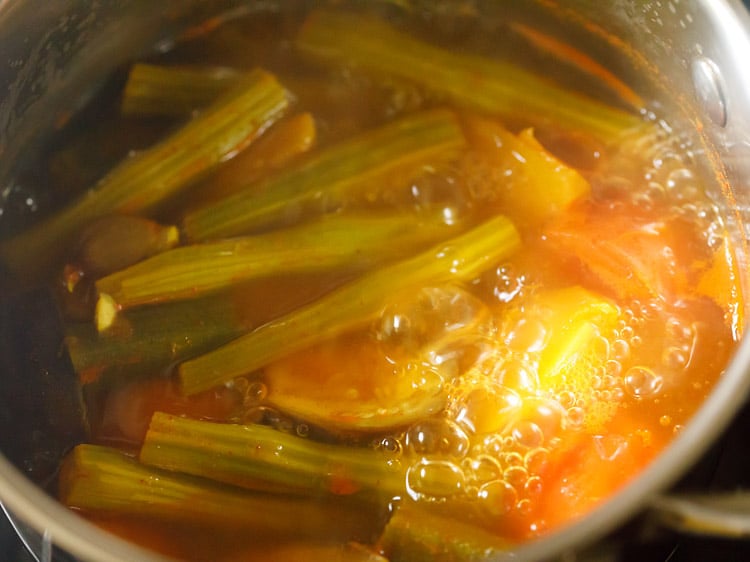
Make Sambar
14. Add the prepared tamarind pulp to the cooked vegetables. If you don’t have dried tamarind then use packaged or bottled tamarind paste.
You can add about ½ to 1 tablespoon of the tamarind paste or add as according to your taste.
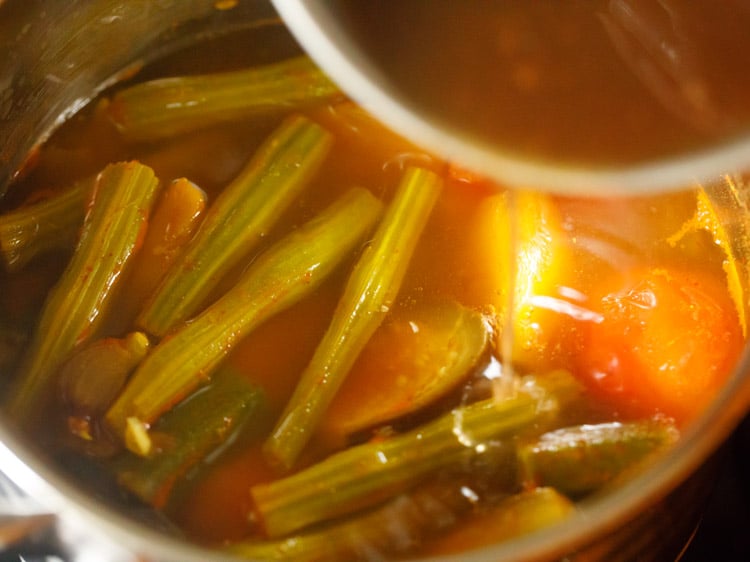
15. Mix well.
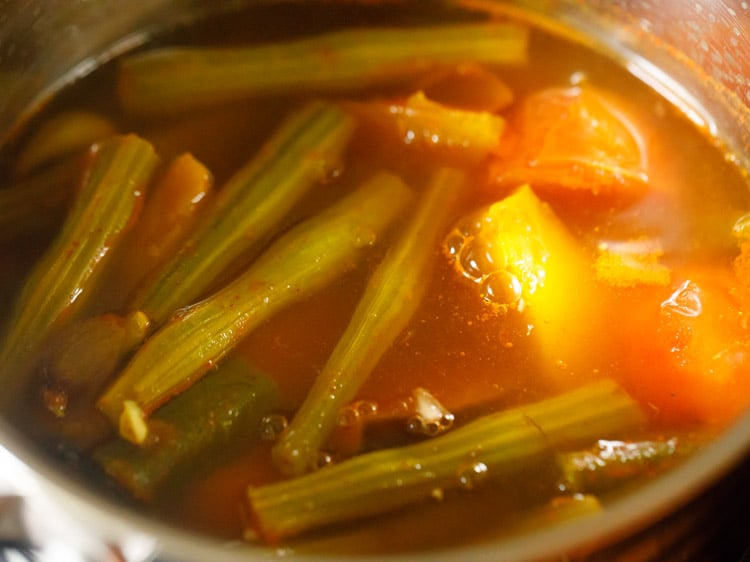
16. Next add 1 to 1.5 tablespoons Sambar Powder. At this step you can also add ½ to 1 teaspoon of jaggery powder. Adding jaggery is optional.
The flavor of your sambar mostly depends upon the sambar powder that you will be using.
So either make your own homemade sambar powder or use a trusted brand. You can buy packaged sambar powder easily online.
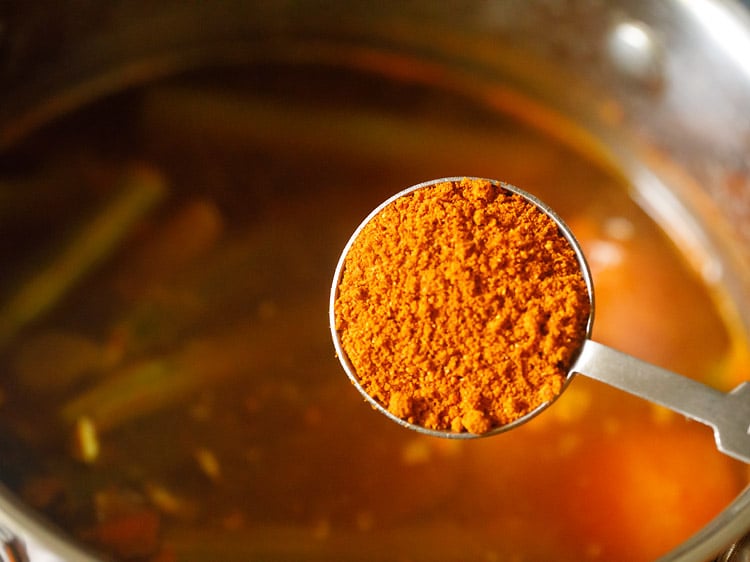
17. Stir and mix well again.
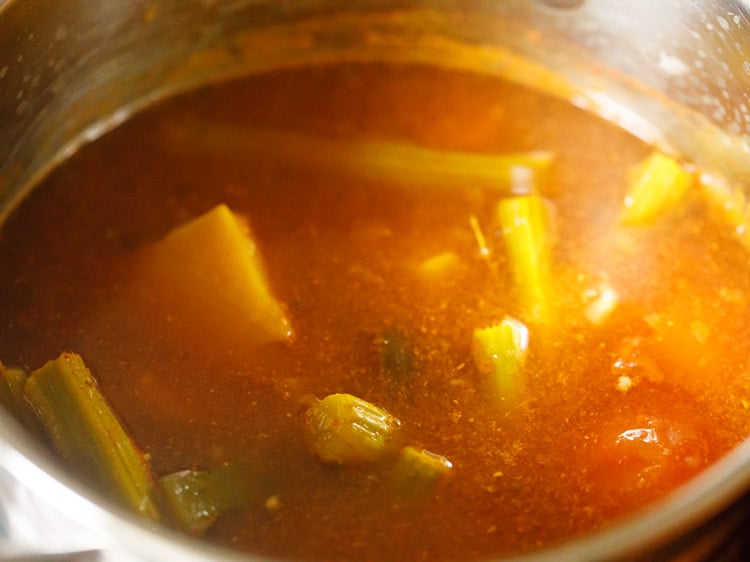
18. Add the mashed dal.
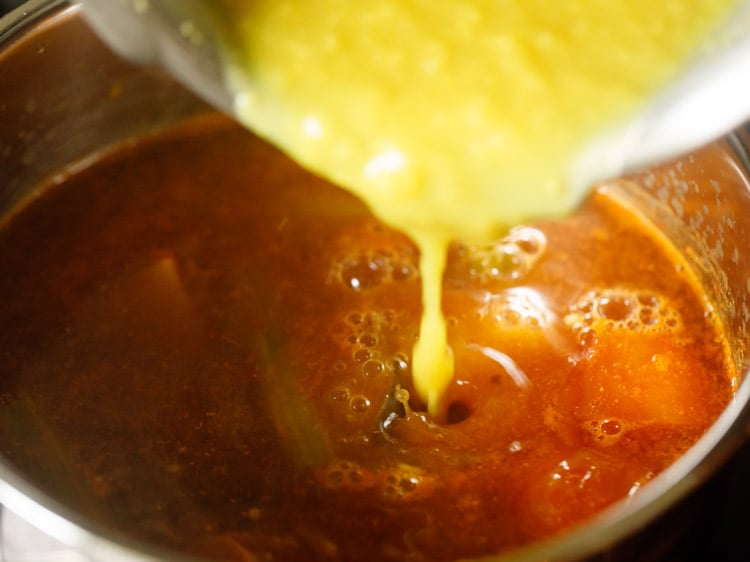
19. Stir and mix very well. If the consistency looks very thick, you can add some water.
You can easily adjust the quantity of water and make medium to thin consistency of sambar. But keep in mind not to add too much of water as this will dilute the flavors.
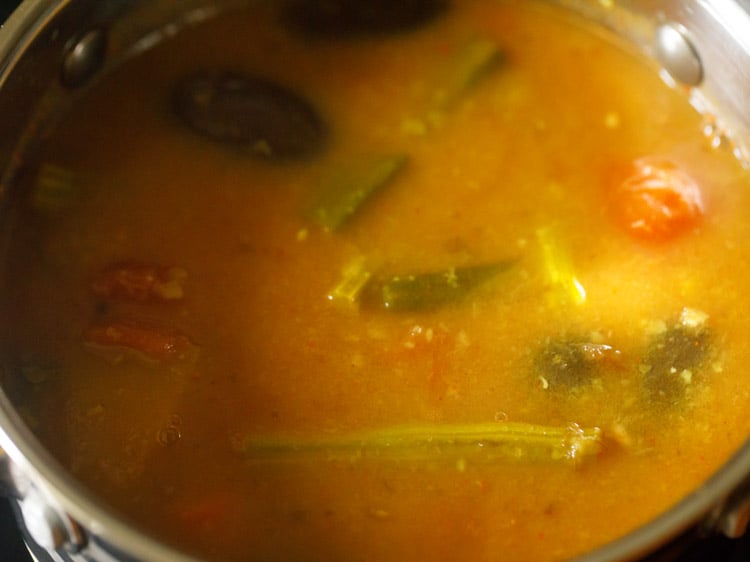
20. Simmer on a medium-low heat till it comes to a boil. Stir at intervals. You will see a frothy layer on top when the sambar begins boiling.
At this step switch off the heat. Cover and keep aside. Check the taste and add salt if needed.
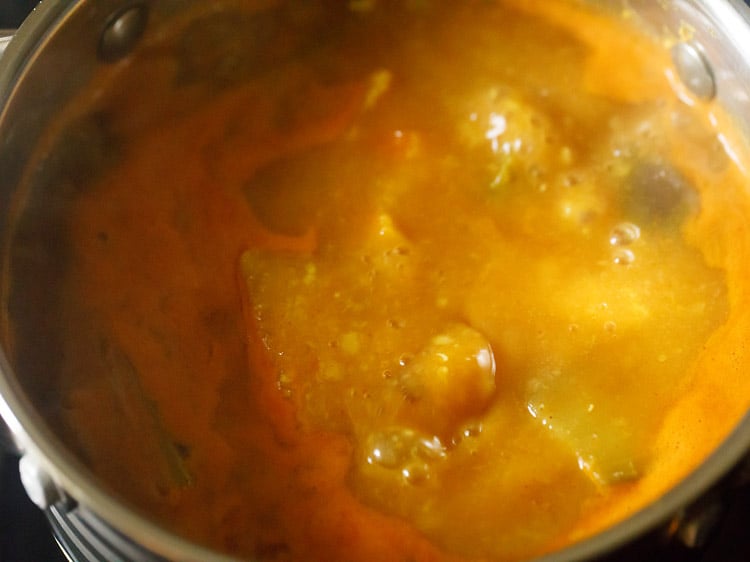
Temper
21. In a small pan or tadka pan, heat 2 tablespoons gingelly oil (oil made from raw sesame seeds).
You can even use sunflower oil, ghee or coconut oil instead. Add ½ teaspoon mustard seeds.
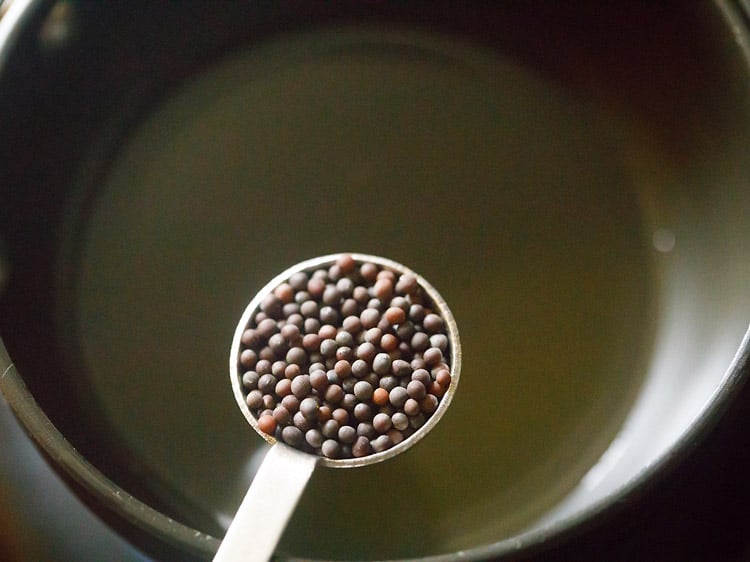
22. Let the mustard seeds crackle on low heat.
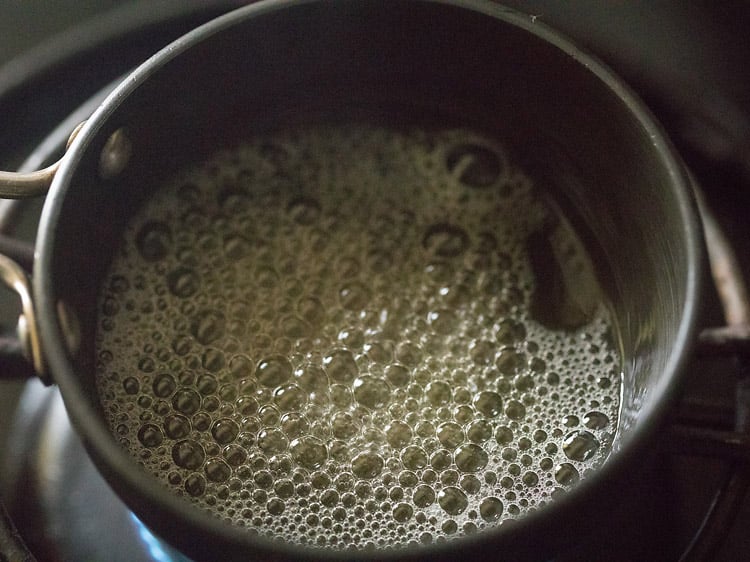
23. Then add 1 to 2 dry red chillies (halved and seeds removed).
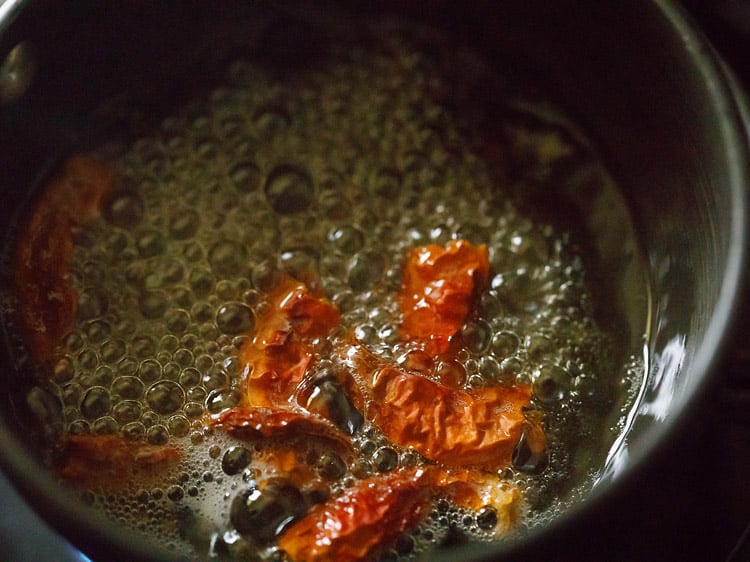
24. Immediately add 10 to 12 curry leaves, 5 to 6 fenugreek seeds (methi seeds) and 2 pinches of asafoetida (hing). Be careful while adding curry leaves as the oil splutters a lot.
Note: To make sambar gluten-free, omit the asafetida and ensure that your sambar powder does not have asafetida or use gluten-free asafetida.
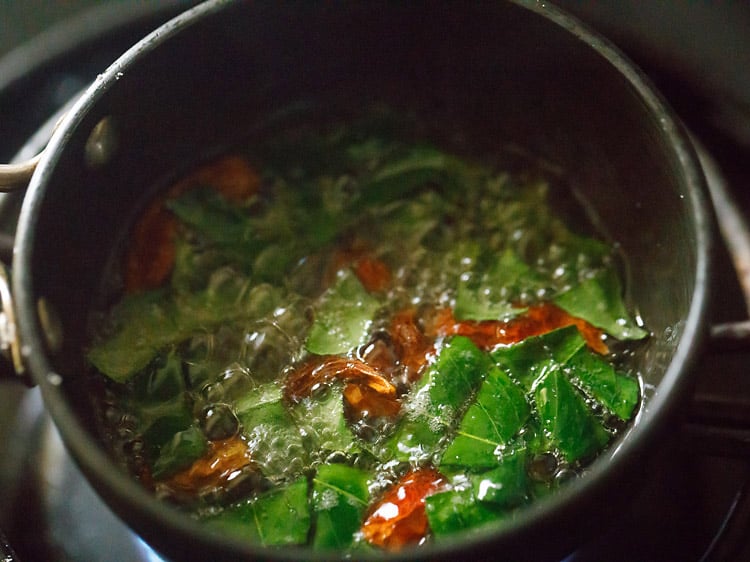
25. Fry them till the red chilies change color and curry leaves become crisp on low heat. Take care that you don’t burn the spices.
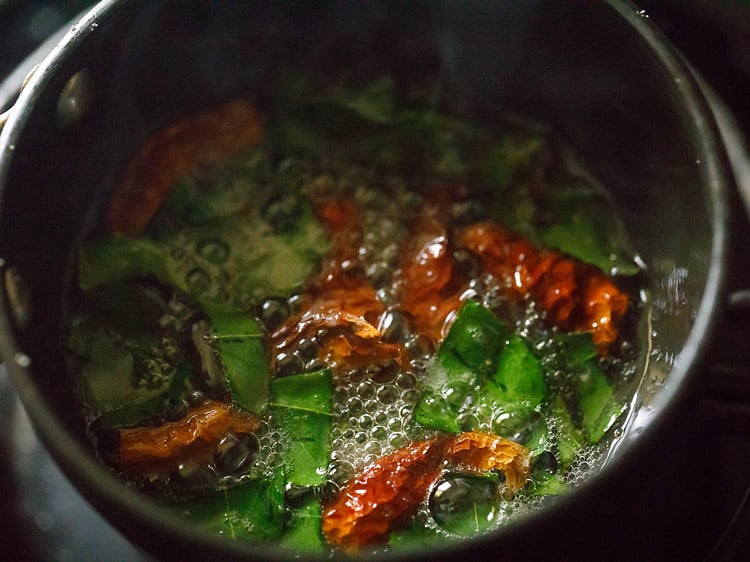
26. Immediately add this tempering mixture in the hot sambar.
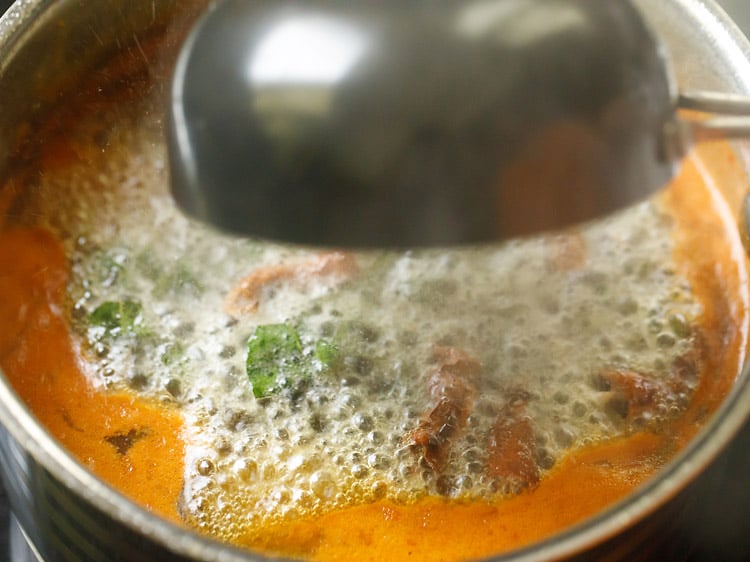
27. Cover the pan with its lid for 4 to 5 minutes, so that the aroma and flavors from the tempering mixture get infused with the sambar.
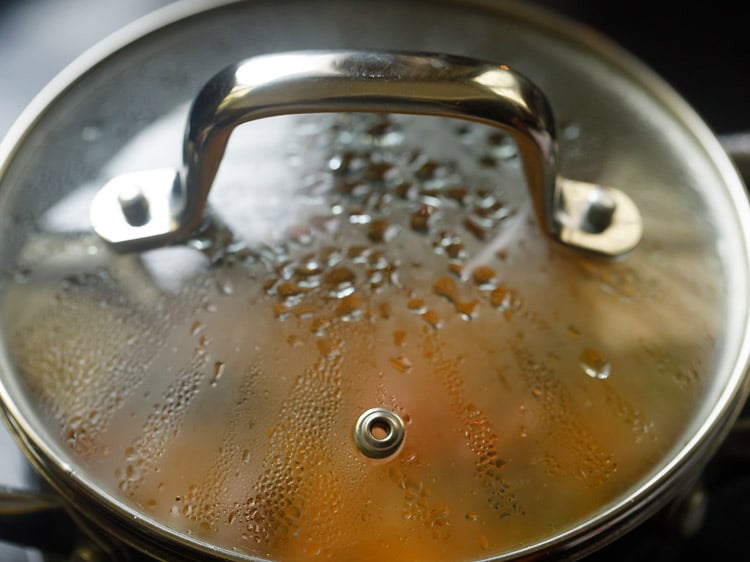
28. Serve sambar hot or warm. Garnish with some coriander leaves if you prefer. Usually, it is is cooked a two-three hours earlier as its taste becomes better with time.
However, we prefer sambar to be served as soon as it is made. It can also be served with steamed rice, idli, dosa, medu vada or uttapam.
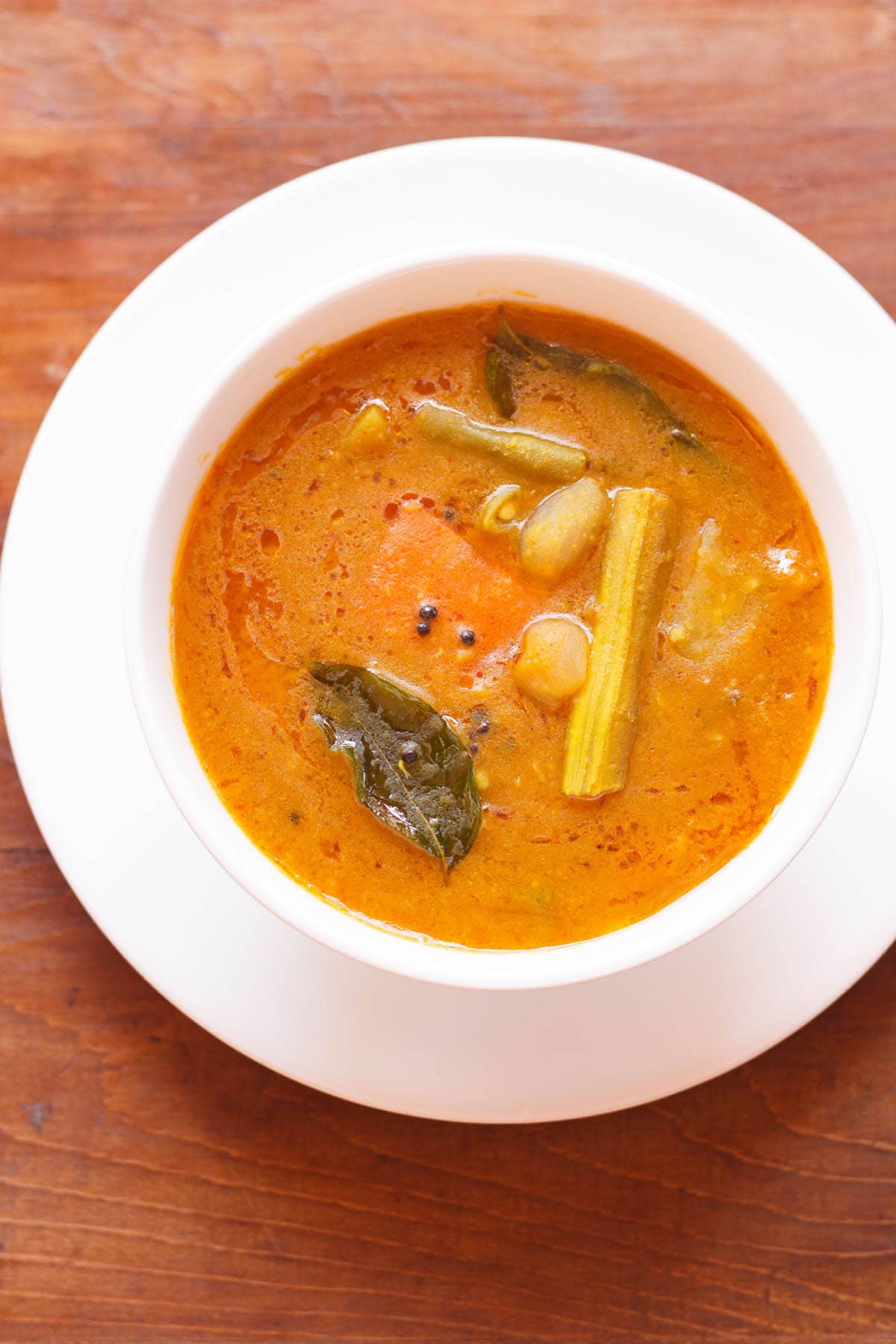
Serving Suggestions
Sambar is served with steamed rice, idli, dosa or medu vadai or uttapam. You can vary the consistency of sambhar and serve it with whatever dish you are making like idli or dosa or rice.
A slightly thin sambhar is served with idli, dosa and medu vada. Medium to thick consistency sambar is served with steamed rice.
Storage and Leftovers
Store sambar in the refrigerator for a day only. The consistency will thicken after refrigeration. Add some water and mix to get your desired consistency and reheat in a pan.
Sambar Variations
There are many variations for making sambhar. Each South Indian state has some variations like adding a specific oil or adding a few more ingredients or spices in the sambar powder.
- In Tamil Nadu sesame oil which is also called as gingelly is used. Gingelly oil is made from raw sesame seeds and is very different in flavors and taste from the asian toasted sesame oil. In Kerala, coconut oil is used often.
- Some sambar recipe variations have making a ground sambar masala paste with or without coconut. In some variations the coconut is roasted till it is golden and then ground to a paste. So depending on the ingredients used, the sambar recipe will have a different taste and flavor.
- In Karnataka, a bit of jaggery is added in the sambar powder. This gives the sambar a faint sweet taste which some people like.
- Mostly pigeon pea lentils (arhar dal, tur dal, tuvar dal) are used when making sambar recipe. But in some variations red lentils (masoor dal) and yellow moong lentils (mung dal) can also be used. A combination of these three lentils can also be added. I mostly make with arhar dal and moong dal.
Which lentils to include
Traditionally sambar is always made with tur dal (arhar dal or pigeon pea lentils). Even moong dal (yellow mung lentils) or masoor dal (orange lentils) can be used to make sambhar.
A mix of tur dal and masoor dal can also be used. On occasions, I also make sambar recipe with only mung dal.
You can also use a combination of tuvar dal and moong dal. In some variations, black eyed beans and whole moong beans are also included.
Choice of Vegetables
Sambar can be made with just one vegetable or a mix of vegetables. The vegetables that can be used alone or in combination are listed below. From the below list you can have a combination of vegetables.
If using greens like spinach or amaranth, then just add them exclusively and do not mix with other vegetables. You can also add your choice of veggies to the sambar recipe.
- Yellow Pumpkin
- Carrot
- Ash Gourd/White Pumpkin
- Drumstick (Moringa Pods)
- Pearl Onions or Shallots or Onions
- Radish
- Tomato
- Okra (Lady Fingers)
- Potatoes
- Eggplants (Brinjals)
- Snake Gourd
- Spinach
- Amaranth Leaves
- Bottle Gourd
- Banana Stem
- Plantain (Unripe Green Bananas)
- Green Beans (French Beans)
- Broad Beans
- Long Beans
- Ivy Gourd
- Field Marrow (Mangalore Cucumber)
Expert Tips
Sambar can be made really flavorful and tasty if you follow some of my handy tips listed below.
- Sambar Powder: The main flavor and aroma of sambar come from using a good and fresh sambar powder. So always use a homemade sambar powder or you can use your favorite brand of sambar powder.
- Type of vegetables: Another flavor and taste elements in the sambar recipe come from the addition of vegetables. So depending on the type of vegetables used, the sambhar will taste different. Personally I prefer a mix of drumsticks, brinjals, pumpkin or ash gourd, pearl onions (shallots), carrots and okra.
- Quality of lentils: Always use a good quality and fresh tuvar dal. The fresher the dal is the better it tastes and cooks faster. For quicker cooking you can soak the lentils for an hour before cooking. For best taste and nutrition use unpolished lentils.
- Tamarind: For tamarind, it is better to use fresh dried tamarind. If you use aged tamarind, then it will be darker in color and more sour. So add a bit less tamarind than what is mentioned in this recipe.
- Cooking vegetables: Always cook the vegetables till they are done but whole. They should not break or become a mush in the sambar. So when cooking, add vegetables which cook slower first and cook them for some minutes. Then add vegetables which cook faster.
More Helpful Tips
- Oils: Both gingelly oil (raw sesame oil) and edible coconut oil give a really good taste in sambaar. If you do not have these oils, then you can even use sunflower oil or peanut oil. For a richer taste you can opt to use ghee.
- Frying spices: While doing the tempering or tadka, always fry on a low flame and stir regularly. The spices and herbs fry fast, so you have to be attentive. If the tempering gets burned, then discard it and make a new tempering. Never add a burnt tempering in sambar as it will spoil the entire taste.
- Consistency: By adding less or more water, you can change the consistency of sambar. But do not add too much water and make it thin as then the flavors and taste gets diluted. For serving with rice you can make a thick sambhar and for serving with idli or dosa, you can make a medium consistency sambar.
- Balancing sourness: In case if you find the taste of sambar more sour, then you can always balance the sour taste by adding a bit of jaggery.
Step by Step Photo Guide Above
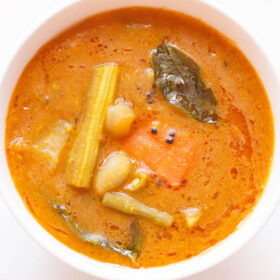
Traditional Sambar Recipe
Ingredients
For tamarind pulp
- 1 tablespoon tamarind
- ⅓ cup hot water
For cooking dal
- ½ cup tur dal or arhar dal (pigeon pea lentils) – 100 grams
- ¼ teaspoon turmeric powder (ground turmeric)
- 1.5 to 1.75 cups water or add as required
For cooking vegetables
- 1 to 1.5 cups chopped vegetables like okra, french beans, potatoes, small round brinjals, pumpkin
- 1 to 2 drumsticks – scraped and chopped in 3 to 4 inches sticks.
- 6 to 7 pearl onions (sambar onions) or 1 small to medium onion, thickly sliced
- 1 tomato – small to medium, quartered or diced
- ¼ teaspoon turmeric powder (ground turmeric)
- ½ teaspoon kashmiri chilli powder – optional
- salt as required
- 1.5 to 2 cups water or add as required
Important ingredient
- 1 to 1.5 tablespoons sambar powder
For tempering
- 2 tablespoons sesame oil (gingelly oil), can also use coconut oil or sunflower oil or ghee
- ½ teaspoon mustard seeds
- 1 to 2 dry red chillies – halved and seeds removed
- 10 to 12 curry leaves
- 2 pinch asafoetida (hing)
- 5 to 6 fenugreek seeds (methi seeds) – optional
For garnish
- 1 tablespoon chopped coriander leaves (cilantro) – optional
Instructions
Making tamarind pulp
- Soak the tamarind in hot water for 20 to 30 minutes.
- Once the tamarind gets soft, then squeeze the tamarind in the water itself. Discard the strained tamarind and keep the tamarind pulp aside.
Cooking lentils
- Rinse tuvar dal a couple of times in water.
- Drain all the water and add the dal in a 2 litre pressure cooker. Also add ¼ teaspoon turmeric powder.
- Add 1.5 to 1.75 cups water and mix. Cover and pressure cook dal for 7 to 8 whistles or 9 to 10 minutes on medium heat.
- When the pressure settles down on its own, open the lid and check the dal. The dal should be completely cooked and mushy.
- Mash the dal with a spoon or wired whisk. Cover and keep aside. You can see the consistency of dal in the pic below.
Cooking vegetables
- When the dal is pressure cooking – rinse, peel and chop the vegetables.
- Take the chopped vegetables in a pan or pot. Also add 6 to 7 pearl onions or 1 small to medium onion (thickly sliced) and 1 small to medium tomato (quartered).
- Sprinkle turmeric powder, kashmiri red chilli powder and salt as per taste. Adding kashmiri red chili powder is optional and can be skipped.
- Add 1.5 to 2 cups water and stir.
- Keep the pan on a stove top and begin to cook vegetables on a medium-low to medium flame. In between do check when the vegetables are cooking.
- Cook till the vegetables are almost done. Ensure that you don’t over cook the vegetables.
Making sambar
- Once the vegetables are almost cooked, then add the tamarind pulp and 1 to 1.5 tablespoons sambar powder. Mix well.
- Add the mashed dal. Mix again very well.
- Simmer on a medium-low heat till the sambar comes to a boil.
- You will see a frothy layer on top when the sambar begins boiling. At this step switch off the heat. Cover and set aside.
Tempering
- In a small pan or tadka pan, heat 2 tablespoons gingelly oil. Add ½ tsp mustard seeds.
- Let the mustard seeds crackle.
- Then add 1 to 2 dry red chillies (halved and seeds removed).
- Immediately add 10 to 12 curry leaves, 5 to 6 fenugreek seeds (methi seeds) and 2 pinches of asafoetida (hing). Be careful as the oil splutters while adding curry leaves.
- Fry them till the red chilies change color and curry leaves become crisp.
- Immediately add this tempering mixture in the hot sambar.
- Cover the pan with its lid for 4 to 5 minutes, so that the aroma and flavors from the tempering mixture gets infused with the sambar.
- Serve sambar hot. You can garnish it with a few coriander leaves if you prefer. It can also be served with steamed rice, idli, dosa, medu vada or uttapam.
Serving Suggestions
- Serve sambar with steamed rice, idli, dosa or medu vadai or uttapam.
- Vary the consistency of sambar keeping in mind the dish you want to serve it with. Example – a medium to slightly thin sambar is served with idli, dosa and medu vada. Sambar with a medium to thick consistency is served with steamed rice.
Storage and Leftovers
- Store any leftovers in the refrigerator for a day only. Note that the consistency will thicken after refrigeration. Add some water and mix to get your desired consistency while reheating in a pan.
Video
Dassana’s Notes
- Sambar Powder: The sambar powder can make or break your sambar. Use the best sambar powder. It can be homemade or from your favorite brand. Sambar powder is easily available online.
- Vegetables: The mix of various vegetables add plenty of their unique flavor and taste to sambar. Thus depending on the type of vegetables used, your sambar recipe will taste different every time. I prefer to add a mix of drumsticks, brinjals, pumpkin or ash gourd, pearl onions (shallots), carrots and okra. Feel free to mix and match the veggies from the list mentioned in the post.
- Lentils: Try to use fresh and preferably unpolished tuvar dal for best flavor and health reasons. The fresher the dal is the better it tastes and cooks faster. For faster cooking, you can opt to soak the lentils in water for 30 to 60 minutes.
- Cooking Lentils: The lentils can be cooked in an Instant Pot or pan on the stove top. Add water as needed. The lentils should be softened and mushy.
- Tamarind: I suggest to use fresh tamarind. If you use aged tamarind, then it will be darker in color and more sour. So add a bit less of the dark tamarind than what is mentioned in this recipe.
- Cooking Vegetables: Always cook the vegetables till they are done but whole. They should not break or become a mush in the sambar. So when cooking, add vegetables which cook slower first and cook them for some minutes. Then add vegetables which cook faster. Note that The vegetables can also be steamed in a steamer or pressure cooker or Instant pot.
- Oils: Both gingelly oil (raw sesame oil) and edible coconut oil give a really good taste in sambar. If you do not have these oils, then you can use sunflower oil or peanut oil or even ghee
- Frying spices: While doing the tempering or tadka, always fry on a low heat and stir regularly. The spices and herbs cook fast, so you have to be attentive. If they get burned, then discard them and make a new tempering. Never add a burnt tempering in sambar as it will ruin the taste.
- Consistency: Change the consistency of your sambar by adding less or more water. However, do not add too much water and make it thin as then the flavors get diluted. For serving with rice you can make a thick sambhar and for serving with idli or dosa, you can make a medium consistency sambar.
- Balancing sourness: In case if you find the taste of sambar more sour, then you can always balance the sour taste by adding a bit of jaggery.
- Variations: A few crushed garlic cloves can also be added to the tempering. This imparts a different flavor in sambar. A bit of jaggery can also be added to give a slight sweeter taste.
Nutrition
Sambar Recipe from the blog archives was first published on July 2009.

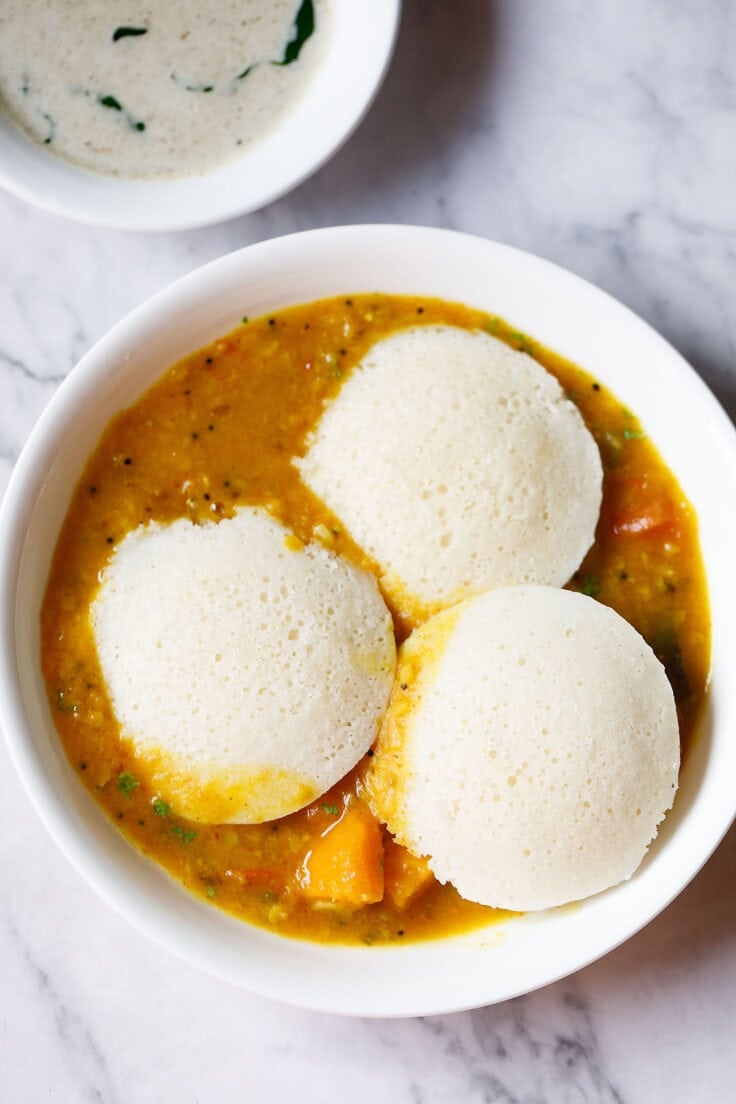
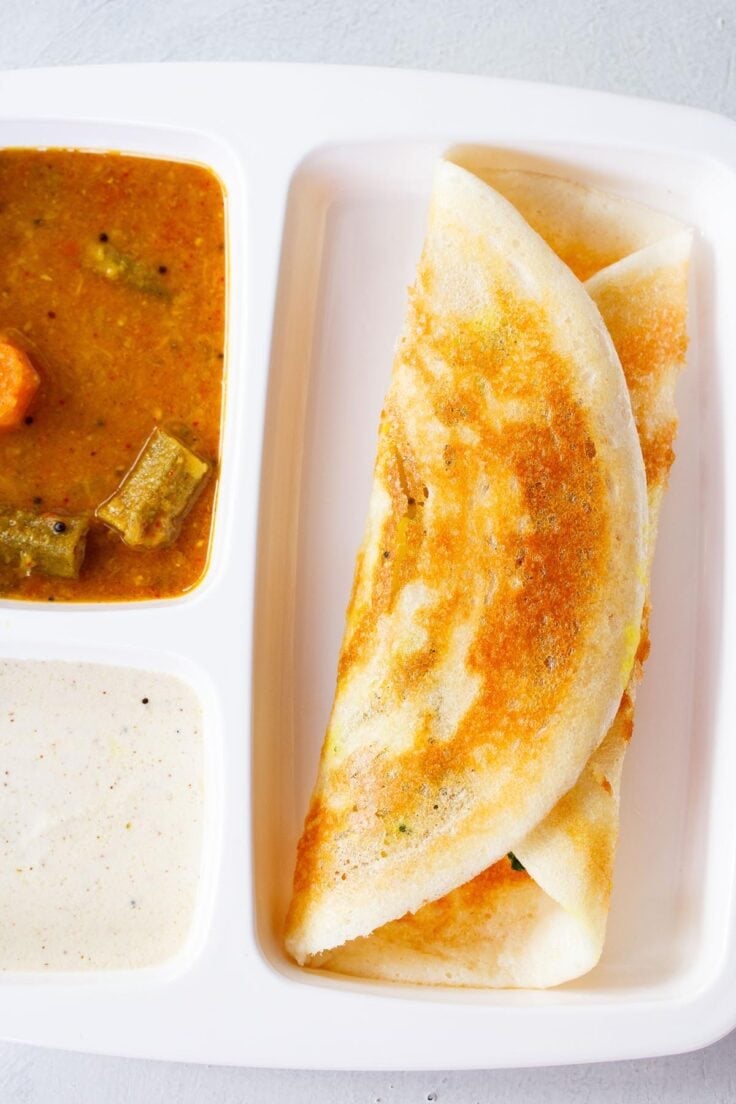
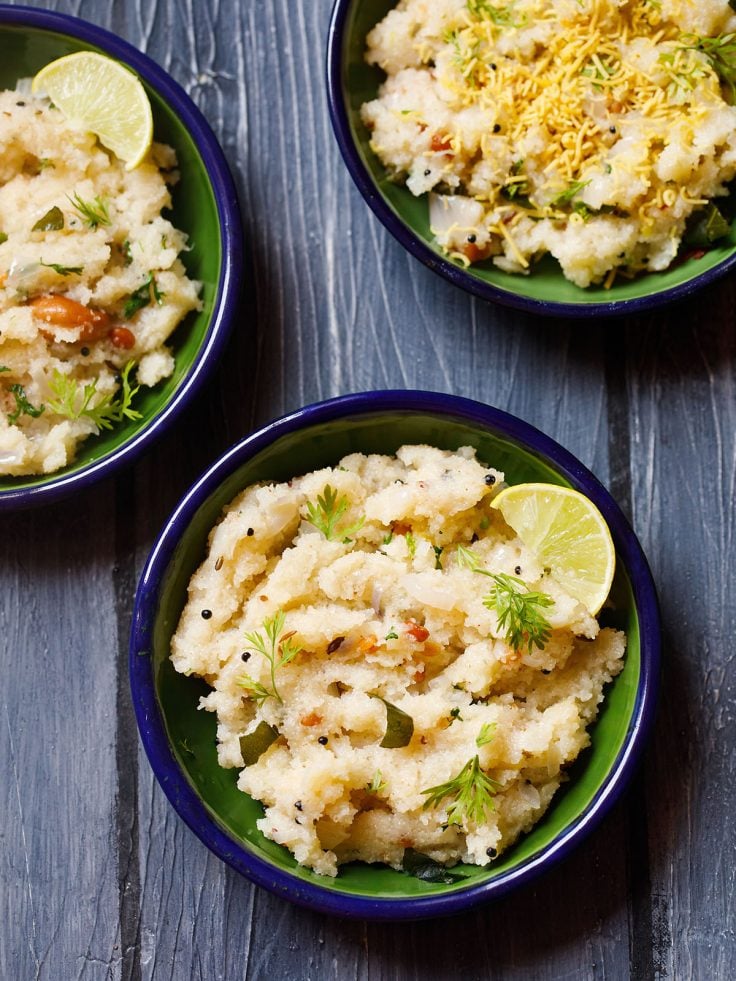
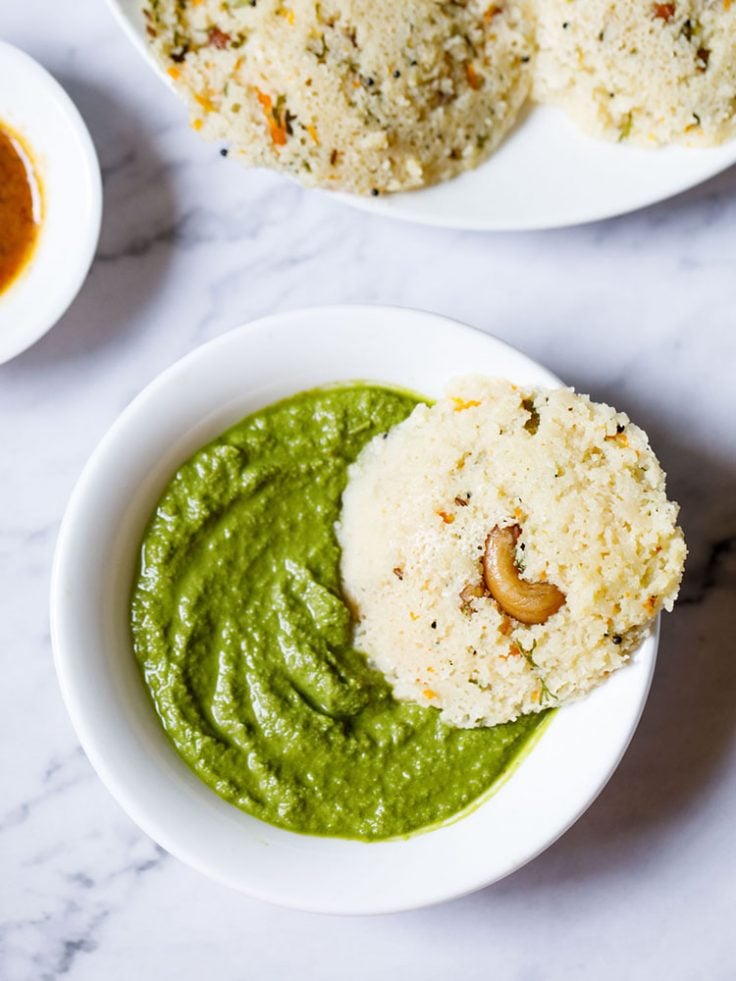
Very tasty and easy recipe.
Thank you so much. I am glad you liked the recipe.
Using the mtr powder for sambar is really great.
Potatoes not great instead pumpkins.
French beans and carrots are best.
Drumsticks really add to the taste
Tomato is a must
Coconut really adds to the dish
Grated amla is a personal secret to the dish.
Hing in Sambar is essential
Dollop of ghee cuts the spice beautifully and adds to the fragrance.
Thanks for sharing your tips. I am sure readers will appreciate them.
I have used this recipe so many times and everytime the Sambhar has turned out amazing.
So glad to hear that the sambar turns out great every time. Thank you for trying the recipe and sharing your feedback.
I’ve used this recipe so many times. I swear by it! Thanks for sharing Dassana!
Thanks a lot.
I followed your recipe using Tuvar & bit of masoor Dal. It came out great.
I made this this evening. For some reason it tasted very tart and a bit overly tangy. I added a little bit of jaggery to mellow it out a bit.
I might use less tamarind next time. Plus it wasn’t that beautiful copper red colour like yours, but brown. Interesting.
The tartness is due to the tamarind quality and it also affects the color. I hope you have made the sambar using dried tamarind fruit and not tamarind sauce or paste. If using a tamarind sauce or paste, you might just need about ½ to 1 teaspoon.
Another clear explained and tasty one for my recipe book…God bless you, Dassana. Namaste !
Thanks a lot.
Loved the recipe. Since I am used to some sweet taste, I add jaggery. The taste was phenomenal and we all enjoyed the sambar with piping hot steamed rice. Delicious!
Thanks for this lovely feedback.
Tried out your Sambar Recipe and turned out well. My grandkids loved it. Have saved your recipe. Thank you!
Nice to know and thank you for sharing your feedback. Welcome.
This recipe makes really tasty sambar of the kind you’ll never find in a UK restaurant!
Thanks a lot.
I was given an idli cooker for Christmas and am keen to make the idli sambar I enjoyed when I stayed in Mysore many years ago.
This looks like a great recipe but do you have a recipe for making sambar powder at home, as I find home-prepared spice mixes have more flavour than those bought from a store?
Yes, I do have a homemade recipe.
You can find the recipe here: Sambar Powder
Thanks for the sambar powder recipe you pointed me to, I made up a jar of this and then made a really gorgeous moringa (drumstick) sambar with it.
And now I have enough sambar podi left to try making some other sambar variations! Thank you!
Great and thanks for sharing with me. Welcome.
great! wanted to learn how to make sambar! thank you, Dassana ?
Welcome and thanks.
1 to 2 drumsticks – scraped and chopped in 3 to 4 inches sticks.
Please explain what these are? I only know chicken drumsticks…….
These are tender and green moringa pods and called Drumsticks here in India.
Thank you. It help a lot for a beginner like me. Sambhar cooked well n taste yum.
thanks rajeev for the feedback and review on sambar recipe. happy cooking.
Hello…Thank you for this awesome recipe….i made today and turned out perfect…..we enjoyed with Idli. will try out other recipe of yours.
It was just superb my dear friend Amit
I really enjoyed preparing and having it with dosa
Thank you soo much
Welcome Dilip. Glad to know that you liked the sambar recipe.
Hi Dassana, I have made this a few times for the family and all love it.
Your recipes are straightforward and down to earth – no special expensive ingredients, just using whatever is in our kitchens yet FANTASTIC results always ! Also, sharing personal tips and stories around each recipe give a special touch that make all your dishes a joy to prepare (and eat !) as if from a cherished family recipe book ! God bless you !
Welcome Dimpy. Thanks for your kind words and blessings. I am happy to know that you are liking the recipes and their presentation style.
Best recipe ever :)…Am not very good in cooking …but your recipes are very clear in qty level and exactly came out well .After a long search this is the only site which actually true in recipe combination .Thank you guys you made my day
Welcome Nisha. Glad to know that you like the website and recipes posted here. All recipes are tried and tested before being published. Thanks for your positive feedback on sambar recipe.
Hi
I love all your recipe
But I have one question that how much Sambar do you make per idli please?
thanks. one small to medium bowl of sambar can be served for one person with 2 to 3 idlis. so you can easily make sambar with 1/3rd or 1/2 cup of tuvar dal. it will serve 5 to 6 people.
wow really excited to find this website! i’m gonna try some of these recipes on my dad when he visits next week…wish this ABCD luck 😉
and thank u for the recipes!
thank anu and wish you all the best. happy cooking ????
Hi!
I love Sambhar…..gonna make for the first time. Could you please tell me any other alternative for tamarind as I stay abroad and it’s difficult to get it. I don’t want to miss that tangy sour taste…..
Thanks,
taste wise there is no alternative to tamarind. abroad, ready tamarind paste is available. so you can use this but add very less as tamarind paste is more concentrated than tamarind pulp made by soaking in water. for a sour taste lemon juice can be used, but the sour taste given by lemon juice would taste different in sambar.
Hi !
I will be trying out your sambhar recipe today.
happy cooking and i hope the sambar recipe turns out good for you.
Mam all of your recipes are very good and the explanation makes them easy to prepare specially the photographs… Made sambar yesterday and it turned out to be delicious…
Thanks Rupali for your positive feedback on recipes. Glad to know that sambar came out well.
The sambar powder’s raw taste didn’t go even after keeping it for low flame for a long time in the stove. Had a tough time making it!
then the issue is with the sambar powder and not the sambar recipe. if the spices were roasted before making sambar powder, then it will get cooked quickly in the sambar. if not, then it will take some time.
hello,just wanted to let u know whenever it comes to trying my hand at cooking,it’s just ur recipes which i can totally rely upon.
Really looking forward to making this sambhar recipe too.
Also, i wanted to know if just one whistle would be enough to cook the vegetables? for example if it’s potatoes,would one whistle do?
Thank u in advance ☺
thanks a lot jayashree. one whistle is fine as the veggies will be half done as they are cooked again after adding sambar powder. so if cooked for 2 whistles than the veggies can become mushy when cooking further. alternatively, you can cook for 2 whistles also and then reduce the later cooking time. but do make sure that there is no raw aroma of the tamarind pulp.
Hello,, is there a substitute for the tamarind in this recipe if it’s not easily available? Thanks
Welcome Ekta. You can add some lemon juice towards the end of recipe. lemon juice is not the substitute but it will give some sour taste in the sambar. add at the very end.
Hi,I’m priya from tamilnadu.I’m just 16 now and I luv cooking.I hope this recipe would satisfy my family,and frnds
Priya, nice to know this. i hope everyone in your family will like the sambar.
hi dassana!!! thank u so much for sharing such easy n well explained recipes…I’ve been following ur website since last year…this year I got married n today I made sambar for the first in my sasuraal…followed all the steps..n it turned out to be very yummy!!! thank u so much…!!!
welcome sandy. glad to know this. thanks for leaving this sweet comment.
Hello, I tried samber recipe for the first time and it tastes awesome. I try many of ur recipes and everytime results are great. Thanks for sharing dear 🙂
Welcome Neetu. Thanks for sharing positive feedback on recipes.
Hai,
Prepared it today and it was delicious. My 3 years daughter loved it too. I blindly follow your recipies and the dishes always turn out to be delicious. Thank you.
Welcome Nanditha. Glad to know this. Thanks for sharing positive feedback on recipes.
Tried this today and it was my first time trying Sambhar. Used the sambhar powder as mentioned and it turned out really well. In US we don’t get all the veggies to go in sambhar but I got a frozen veggie packet especially for Sambhar that even had the drumsticks and it was delicious. My husband who is a very picky water relished it. Thanks for sharing.
Welcome Daisy. Thanks for sharing your positive feedback. Glad to know that you and your husband liked the sambar recipe.
I made sambar yesterday… Had known the basics of making it but I learnt and tried some more flavour-adding tips from this recipe. Everyone loved the result. Thank you for sharing all these wonderful recipes 🙂
The best part of sambar is that not only is it very easy to make but also very healthy. one can include all sorts of veggies whose individual, traditional sabzis would take much more time than the sambar
agree ruchi. sambar is healthy as well as one can add variety of mixed veggies in it. thanks for sharing this. happy cooking 🙂
Thanks for sharing this recipe
welcome fousiya 🙂
welcome fousiya.
Thank you for sharing this recipe awesome taste
welcome aafreen thanks for positive views 🙂
Hey dear when to add d tamrind pulp.
see the 6th step in both the recipe card and the step by step pics.
Hello Dassana,
This sambhar recipe is so simple yet flavourful and that is the best thing about your recipes.
Your effort of adding pictures to the recipe is just commendable. Pictures helps a lot to understand the quantity and color till which to saute/cook.
Thanks for such an awesome blog .
Regards
Ritu
thank you ritu for your positive and motivating words. glad to know you like the step by step pictures and you are welcome 🙂
Hi Amit..
i try ur recipes whenever i try smthng new… All reciepes were awesome.. Today i tried sambhar recipe.. n yes its as usual awesome.. Thnks ?
pleased to know this thank you so much amruta for your kind words.
I also add coconut paste at the end…adds a distinct flavour
true and thanks for sharing.
Today m Gonna prepare sambar for the first time.. will share my experience with you… ?
sure kannu do let us know? thankyou.
It was really tasty ma’am.. ☺☺
My father loved this recipe..
Thank u for sharing ur amazing recipes.
welcome always kannu thankyou for your kind words.
Today I am preparing it again ma’am.
your awesome recipe… My father’s favorite.. ?
thank you 🙂 and happy cooking 🙂
..simply amazing. my first dish as forced bachelor turned out to be the best sambar I had. thanks
welcome vijay. glad to know this.
I just recently returned from my second trip coaching a student for the Young Chefs Olympiad and I must say that this is an excellent sambar recipe. I fell in love with the stuff so I just made this one and it makes me feel like I’m back in Kolkata. I was very sorry to hear of the tragic accident yesterday in that city. But again, wonderful recipe!
thankyou kevin for your kind kind gesture and generous words 🙂 glad you liked the sambar recipe god bless you.
Hi prasad here again , prepared my second dish sambar finally with your guidance learned how to make sambar and yes it came to be perfect and everyone in home likes it a lot ?? thank you again for dis easy recipe and i am going to try all of ur recipe for sure
very pleased to know this prasad 🙂 thankyou for your kind and positive words glad you liked the sambar. wish you luck.
I like South Indian food very much..and it help me to make it easy….so thank.
glad to know rohit and thanks.
i have tried many times making sambhar and do not satisfy by result..after reading many comments i will try this recepie for sure…hoping it turn out well..
do try haizel and i hope you will like the recipe.
10/10 recipe best ever sambar
thankyou so much rajeev 🙂
Hey!
It looked real simple when I read it. This was the first time I tried cooking sambar.
You say it takes just 45 minutes, but then waiting for the pressure to cool now and then takes a lot of time, doesn’t it?
Thank you so much for this, though. Cooking seems simpler to me because of your recipes. 🙂
thank you anya. yes it does take time for the pressure cooker to cool. but in meantime we can chop the veggies and do the other prepping required for the tadka as well as prepare the tamarind pulp.
Thank You !!!
For the first time we tasted authentic SAMBHAR @ home only because of you 🙂
thanks a lot rohit 🙂
Hi dear…
Your recepies are simply amazing… they are so easy and are perfect in all proportions.
really have to tell you i prefer your recepies over many renowned chefs. Your recepies are the best.
keep posting more.
thanks alot.
quite pleased to know this deepika 🙂 thankyou so much for your positive words.
Thanku so so much for this wonderful recipe… I am from Punjab and my husband loves south Indian food… today I tried this sambhar recipe and it turned out amazing.. he was soo happy after tasting my first Sambhar… Thanku once again… Ur website is amazing… m gonna try all your recipes…
pleased to know amy your husband loved the sambar 🙂 surely try more recipes and let us know how they were? thankyou so much and you are always welcome.
Very easy recipe. Can you tell me how to make tomato achar
thankyou ranjana 🙂 we are adding your tomato achar to our request list.
Hi Dasanna.. I generously follow ur recipes.. and they come out well… I would like to know the sambar powder recipe as well… so kindly pls do post it some time….
thankyou mrinalini 🙂 pleased to know this have added sambar powder recipe to our request list 🙂
Hiya, I want to try out your recipe, just one question. Instead of soaking imli, can I substitute that with imli paste? and if so, how much should I use?
yes you can use imli paste. try add 1 tsp first and if you feel you need more sourness, then you can increase from 1/2 to 1 tsp more.
Great recipe!! Thanks a lot! Made sambar for the first time today and it turned out amazing!
glad to know this sash 🙂 thankyou so much.
Hi Dassana! I have been following this recipe successfully from a long time and it never fails. Its easy and wonderful. Can you give us an idea to make home made sambhar masala? I use Everest masala but I want to use homemade masala. Kindly help.
rajshree, i have sambar masala powder in the drafts. i will post it after navratri gets over. for sure 🙂
Fantastic recipe!! This was first time I tried sambhar. this came out superb. My hubby n family appreciated it a lot. Thanks for sharing your recipe
welcome joji. nice to know this.
I made sambhar for first time and it turned out to be so good
Thank you
welcome karishma
Your pavbhaji recipe is awesome I make best the best phav bhaji ever thanks a lot
welcome nishi
Can I use chana dal in place of arhar dal plz tel me
nishi, you can use but it will take more time to cook than arhar dal. and taste will also change.
what is sambar masala how can one make thins at home please
Sambar masala is sambar powder made with spices. Can be made at home easily.
Thanks for the recipe…easy preparation … and it came out great the last 2 times I tried.
welcome ajit. glad to know this.
very easy n tasty …..thanks for teach us this recipe
welcome avtar
thanks a lot for sharing such a wonderful recipe…i made sambhar using your recipe yesterday & my husband gave the best food compliment i hv ever received…i told him ‘Thanks to Vegrecipes of India’. i had tried a lot of other recipes but nothing worked out like this one. Thanks for making my day & for sharing this wonderfully delicious recipe 🙂
welcome simmy. glad to know this. thanks for sharing positive review.
Its really a very fine way to make food without disturbing others ,, n all goes to this site…. u guys doing best done,, so pls pls pls continue….
thanks arpita.
Such an easy method to prepare delicious sambar…I have been making sambar for over a year but this time it turned out to be so delicious….and thanks for using sambar powder otherwise with 15 different spices it would be out of my reach 🙂
Awesome recipe….I tried it and sambar turned out to be so delicious…its absolutely simple …I thought you would use 15 different spices and it would be out of my reach but thanks you used sambar masala 🙂
thanks for the positive review pallavi.
Dassana, i must say that your recipes are not just delicious but they truly reflect the ‘goodness’ in you. with such clarity you post the details that even a novice like me ends up making really Good food. thanks to you , Dassana!
welcome kajal. glad to read your positive feedback. thanks.
Really divine n delicious. Would like to give u lots of credit for getting all that combinations right in almost all recipes. Thank you for getting us to try all our Indian wonderful cuisine .
welcome mohan. thanks for sharing positive feedback.
Worlds best sambhar thnx for helping people like me and making life easier by posting such delicious recipes. Ma’am can you please post recipe of this italian dish called “crostini”. thnak youuu!!!!!
welcome riya. thanks for your sweet feedback. i have noted down the recipe request.
Dear Amit ji,
Awesome recipe, I was able to make tasty and aromatic sambhar. Question:
In step 6 , do youn us to use the pulp or the strained tamarind juice ?
welcome. soak the tamarind in warm water for 30 minutes. its the pulp which has been made in step no 2. you can strain the tamarind pulp if you want.
Liked this
All recipes are good
thanks kalpana
After cooking the dal in the pressure cooker, do I drain off some of the remaining water? How watery should it be? I see the consistency of the dal but I can’t see how much water is left in the pot. Thank you. I am eager to try this.
you don’t need to drain the water. just mash the dal along with the water. its medium consistency.
Today i try this recipe.good taste my husband like so much this dish
thanks seema for sharing positive feedback.
Thanks! My very first sambhar came out well. Hubby dearest was even surprised. 🙂
Welcome Jiji. Good to know this.
Easy & Super yammy !!! I am not the Sambhar fan. But love this one. Love the way you post pics & explain. Thanks.
welcome toral. glad to know this.
V delicious recipe -as always !
thanks sushma
Delicious recipe… Yummy Sambhar!! Thanks fr sharing 🙂 Do you have a recipe for Sambhar Masala as well?
thanks ruchi. sambar powder will be added soon.
Onion and tomatoes also will have to be pressurecooked with other veggies or these need to br fried separately??
onions and tomatoes are pressure cooked with the other veggies. they don’t need to be fried separately, since this is a quick version.
Very nice recipe
i like this sambar
Hi mam,
First of all thanks for sharing this wonderul recipe here.
I was able to make my First sambar in a very decent way by using this recipe.
But for me it felt lightly sweeter……what my be reason mam.
Thanks for your recipe.
welcome. did you add carrots or any other sweet tasting veggies. and if yes, then how many?
initially it felt sweet, after some time it was good.
In case if i have only onions and tomatoes, then how much qty should i add.
Thanks for your reply.
fine. you can add easily about 2 to 3 medium onions or 1 medium tomato. in this case, the sambar will be more like onion sambar. just slice the onions thickly. you can also use shallots or small onions. or you can add about 1 medium onion and 2 medium tomatoes. this would be like tomato sambar.
ok mam.Thank you.
welcome vanadevan
Awesome thank you for sharing the great recipes of India I love your website! Will try this recipe pretty soon 🙂
thanks.
It look sooo yummy. I had a question though, can i make cabbage sambar in the same way?
usually cabbage is not added to sambar. but you can try with the same recipe.
Really its so easy and very tasty. Thanks a lot…
welcome namita
i have tried it for the first time and it was better than the regular sambars i had,
i am from andhra and i felt i was in chennai having this sambar from sarvana bhavan.
thanks a lot , the recipe was very easy .
wish you good luck.
welcome K. NARENDRA. this is a really a very positive and sweet feedback. considering the fact that your are comparing the sambar with sarvana bhavan samabr. i have heard a lot about sarvana bhavan food.
HI ,
I have one Question, you forgot to say when to add the tamarind paste..
justin, its mentioned in the recipe. it is step 6
Add some sugar also then it will be good
Hi
Thanks a lot
I tried ur recipe when I was cooking sambar for the first time.
It was too good
Thanks for all the appreciation I got because of you
welcome sheetal. good to know that sambar turned out well.
Hi, I am also from udupi, but i dont remember anyone in my family using garlic.
Is it really necessary?
no its not necessary. you can skip. in udipi they don’t use garlic. but i have one aunt from mangalore, who adds garlic in the tempering in the sambar and we have learnt it from her.
Thanks a lot.. Ur recipe saved me.. It was damn tasty
welcome rashmi
Hi Dassana,
Your recipes are really great, easy steps and most delicious. I am a regular follower of ur site.
Could you please post a recipe for Sambar powder?
Also will be happy if you post more Karnataka cuisine recipes.
Regards,
Shweta
thanks shweta. will be adding sambar powder and hopefully will try to add recipes from karnataka cuisine.
Hi i have made sambhar with this lovable receipe nd the outcome result was super delicious mouth watering thanks u so much dassana for sharing this wonderful receipe
welcome ruchika and thanks for this positive feedback on sambar.
Hi,
This was my first attempt to make Sambar and i was really successful. :). I am very happy with the outcome. Your easy steps really helped me to make it very quickly and easily with out any worry. This is giving me confidence to cook. Thanks to you dasanna.
thanks sundeep.
I tried your sambar recipe today. It was my first attempt and turned out to be awesome. My husband loooved it and has asked me prepare it again for my in-laws. Thanks a ton Dassanaji……
welcome subreen. glad to know that you all liked the sambar recipe. do try more recipes from the blog.
Though it was my first try of making Sambar… The taste and aroma was beyond imagination. !
Thanks a lot for making it very simple recipe…. Really .. Awesome.. !
Only one more thing to ask.. How can I make it look more red.. ?
Also.. is it possible to use freshly made sambhar masala.. at home.. ?
Thanks again.. Keep posting.. !
thanks. the sambar will have a red color, if you use byadagi chili powder or kashmiri chili powder. if the sambar masala has these red chilies than also the sambar will have an orangish reddish color to it. you can make sambar masala at home and keep in a jar. i don’t have a recipe now, but i am sure you will get it on google search 🙂
dassanaji…my first attempt was easy vegetable pulao…good….second palak paneer…goood…egg parantha….again goood….now sambhar….good of the highest order!
i got drumsticks as well……..i have closed the lid now after pouring the tadka….slurpp….my mouth is watering…cant wait to open it!:)
thanks sajith. enjoy your meal.
please tell me how I can prepare the sambar masala .Is it any readymade kind of masala?
sambar masala or sambar powder can be made at home or brought from outside. i don’t have any recipe on the blog as my family is generous enough to share the sambar masala, they make at home with me. i will add a homemade sambar powder post soon.
Today I also going to make sambhar..
Hi..i follow the same recipe…will be good if u add some asafoetida before tempering..will give good aroma and flavour to the recipe….
Thanks
Salini
thanks shalini. sometime i also add asafoetida and it improves the taste slightly and also good for digestion. i will update in the recipe.
I made sambar using ur recipe with the medhu vadas and it was too good and delicious..
thanks suhani
This is my first sambar curry at home it was great thanks
welcome naztaj
The sambar was tasty. My hubby just loved it.
thanks.
Tried my sambar first time and it was awesome. My hubby loved it.
Thanks!!! Made it thru my first sambar without much tragedy!!!
welcome suzanne
Hi superb udupi recipes..just mouthwatering n real..thanks..
thanks anupama
Can you please give some idea about the quantity of vegetables to be added (bottle gourd, ladyfingers, french beans, potatoes, onions, tomatoes). Also, how much is a “ball” of tamarind?
Also, thanks for your all your great (and simple) recipes, they’re perfect for beginners like me!
if using 1 cup dal, then you can add about 1.5 to 2 cups of chopped veggies except the onions and tomatoes. one medium sized onion or 5-6 shallots are enough. 1 medium or large tomato is fine. one ball of tamarind is approx 1 to 1.5 tbsp seedless tamarind. basically a lemon sized ball of tamarind. thanks.
Thank u for the easy cooking
Thank u for the easy cooking….
I like all of your recipes thank you .
thanks nishat.
please tell me if you have posted the recipe to make sambar powder in your website.
i have not yet posted. but will definitely add in some days.
Idili sambar hi hi hi
Thanks for sharing
Best
i got try it,very nice and delicious.sailu malaysia
Thanks buddy..
Made my first sambar today..!!!